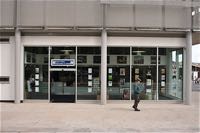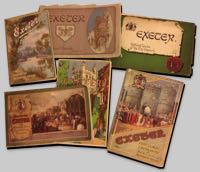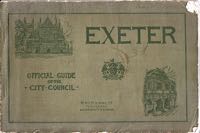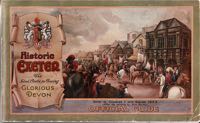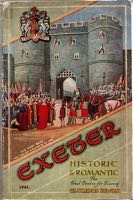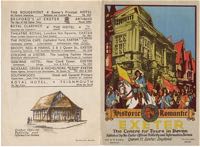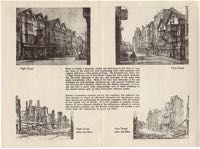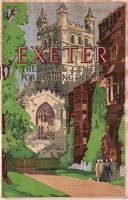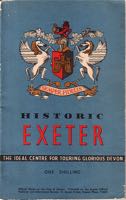
The Exeter Official Information Bureau
Now the Visitor Information Centre
Page uploaded on 30th November 2015
The Exeter Visitor Information Centre at the top end of Southernhay, is the first stop for anyone visiting Exeter for the first time, to get information on places to stay, visit and for booking tickets. Now run by the City Council, the Information Centre started life as a City Council supported, private company to increase visitors to the city, back in 1911.
The idea for promoting Exeter for visitors was proposed at an public meeting at which a committee was set up. The committee met for the first time on 18 April 1911, at the Chamber of Commerce, tasked withopening and running a shop to which visitors, and others could visit about places to stay, and places to visit in the city. Premises had been found opposite the museum, and at which, the AA had agreed to contribute towards the costs, for their members to make inquiries. Mr G F Vallance, recently retired from the position of superintendent of the London and South Western Railway, was appointed as the secretary.
Known as the Exeter Official Information Bureau, the bureau opened at 21 Queen Street, opposite the museum. Funded through subscriptions from business, and a small grant from the City Council, it quickly produced the first official city guidebook. Even through the First War, the Bureau promoted the city, including, from November 1916, the newly opened St Nicholas Priory. In 1924, Exmouth started contributing funds, as Exeter became the centre for touring Glorious Devon.
In 1930, there was a 400% increase in the number of guides issued, from the previous year. The bureau had 6,485 visitors wanting information, and 7,000 guides were posted, many to other countries. To bureau also rented in March 1931 a 34ft by 13ft 6in illuminated sign in Trafalgar Square for four weeks with the legend “Come to Exeter, the centre for Glorious Devon.”
The move to Paul Street
In 1929, Paul Street bus station was opened, after that half of Paul Street had been demolished through the previous years. This seemed like a good place for the Information Bureau and in November 1930, plans were in place to build a purpose designed office on the corner of Paul and Queen Street. The city council paid for the building, which the bureau would rent for £60 per annum. A tender from Messrs. G Herbert was accepted and the Tudor style bureau was opened on the 28 July 1931 by Mayor Alderman C Warren, who nailed a horse shoe above the entrance for luck. It was designed by Mr J Bennett, of the city council, and cost £550. Constructed of timber and asbestos, the facility consisted of a front office, a rear private office, store rooms and washrooms for the staff.
In 1933 the bureau had 8,639 callers, and despite a bleak economy, was proving it could increase the number of visitors to the city. 1934 also saw an increase in visitors, including many from the United States. Commander R. M. Taylor, secretary of the Official Information Bureau said “There were large number of foreigners among the visitors, and it was noticeable that Americans were more numerous than they had been since a great many visitors, of course, are passing through Exeter on their way the coast, but I think quite a large percentage stay at Exeter and make it a centre for visiting the seaside regattas and resorts.”
At the Rougemont Hotel, Mr. Morgan Edwards (managing director) said that in Exeter and on the south coast of Devon generally, bookings had been increased for July and August in comparison with 1933. The same year the Bureau granted the Devon Archaeological Association £15 to prepare a handbook about the ancient underground passages of Exeter. Seven hundred persons had paid for admission since the passages were reopened at Easter.
Just before war broke out, the bureau had 12,011 visitors, and would no doubt, continue attracting visitors. The last of the thick, old style guide books was for 1942. Of course, all notions of tourists and visitors disappeared after the May 1942 blitz, and a large part of the city was raised to the ground. A modest, coloured and folded leaflet was produced in 1944, before a reduced guide book, on cheap pair was printed for the 1945 season.
Both through the 1930s and after the war, a common site outside the Bureau was a number of little handcarts. These were used to hand deliver parcels and packets that were brought from other parts of the county, and further afield, on the bus and coach system. When Paul Street bus station closed, and the Paris Street bus station opened, the Bureau remained in its little kiosk. The City Council took over the Information Centre in 1974. The building was demolished to make way for the Guildhall Centre in 1980, and moved to the Civic Centre as the Visitor Information Centre. It moved to a unit in the Princesshay development, at the top of Southernhay in 2007.
Sources: British Newspaper Archive
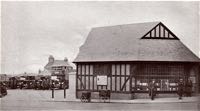
The Tudor style Information Bureau at Paul Street bus station. Notice the hand carts for delivering parcels.
│ Top of Page │
